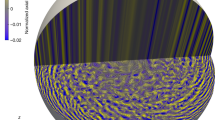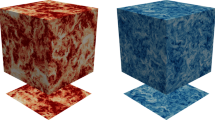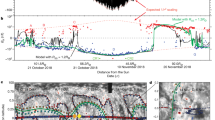Abstract
The gas in the convective outer layers of the Sun rotates faster at the equator than in the polar regions, yet deeper inside (in the radiative zone) the gas rotates almost uniformly1,2,3. There is a thin transition layer between these zones, called the tachocline4. This structure has been measured seismologically1,2,3, but no purely fluid-dynamical mechanism can explain its existence. Here we argue that a self-consistent model requires a large-scale magnetic field in the Sun's interior, as well as consideration of the Coriolis effects in the convection zone and in the tachocline. Turbulent stresses in the convection zone induce (through Coriolis effects) a meridional circulation, causing the gas from the convection zone to burrow downwards, thereby generating the horizontal and vertical shear that characterizes the tachocline. The interior magnetic field stops the burrowing, and confines the shear, as demanded by the observed structure of the tachocline. We outline a dynamical theory of the flow, from which we estimate a field strength of about 10−4 tesla just beneath the tachocline. An important test of this picture, after numerical refinement, will be quantitative consistency between the predicted and observed interior angular velocities.
This is a preview of subscription content, access via your institution
Access options
Subscribe to this journal
Receive 51 print issues and online access
$199.00 per year
only $3.90 per issue
Buy this article
- Purchase on Springer Link
- Instant access to full article PDF
Prices may be subject to local taxes which are calculated during checkout

Similar content being viewed by others
References
Thompson, M. J.et al. Differential rotation and dynamics of the solar interior. Science 272, 1400–1405 (1996).
Kosovichev, A. G.et al. Structure and rotation of the solar interior: initial results from the MDI medium-l program. Sol. Phys. 170, 43–61 (1997).
Schou, J.et al. Helioseismic studies with SOI-MDI of differential rotation in the solar envelope. Astrophys. J.(in the press).
Spiegel, E. A. & Zahn, J-P. The solar tachocline. Astron. Astrophys. 265, 106–114 (1992).
Elliott, J. R. Aspects of the solar tachocline. Astron. Astrophys. 327, 1222–1229 (1997).
Turner, J. S. Buoyancy Effects in Fluids(Cambridge Univ. Press, (1973)).
McIntyre, M. E. in The Solar Engine and its Influence on Terrestrial Atmosphere and Climate(ed. Nesme-Ribes, E.) 293–320 (NATO ASI I 25, Springer, Berlin, (1994)).
Starr, V. P. Physics of Negative-viscosity Phenomena(McGraw Hill, New York, (1968)).
Kumar, P. & Quataert, E. J. Angular momentum transport by gravity waves and its effect on the rotation of the solar interior. Astrophys. J. 475, L133–L136 (1997).
Zahn, J-P., Talon, S. & Matias, J. Angular momentum transport by internal waves in the solar interior. Astron. Astrophys. 322, 320–328 (1997).
Gough, D. O. in The Energy Balance and Hydrodynamics of the Solar Chromosphere and Corona(eds Bonnet, R-M. & Delache, P.) 3–36 (IAU Colloq 36, de Bussac, Clermont-Ferrand, (1977)).
Plumb, R. A. & McEwan, A. D. The instability of a fixed standing wave in a viscous stratified fluid: alaboratory analogue of the quasi-biennial oscillation. J. Atmos. Sci. 35, 1827–1839 (1978).
Andrews, D. G., Holton, J. R. & Leovy, C. B. Middle Atmosphere Dynamics(Academic, New York, (1987)).
Gough, D. O. in Solar-terrestrial Relationships and the Earth Environment in the Last Millennia(ed. Castognoli-Cini) 90–142 (Soc. Italiana Fisica, Bologna, (1988)).
Cowling, T. G. Magnetohydrodynamics(Interscience, New York, (1957)).
Haynes, P. H., McIntyre, M. E., Shepherd, T. G. Reply to Comments by J. Egger on ‘On the “downward control” of extratropical diabatic circulations by eddy-induced mean zonal forces'. J. Atmos. Sci. 53, 2105–2107 (1996).
Haynes, P. H., Marks, C. J., McIntyre, M. E., Shepherd, T. G. & Shine, K. P. On the “downward control” of extratropical diabatic circulations by eddy-induced mean zonal forces. J. Atmos. Sci. 48, 651–678 (1991).
Gough, D. O.et al. The seismic structure of the sun. Science 272, 1296–1299 (1996).
Elliott, J. R. & Gough, D. O. The thickness of the solar tachocline. Astrophys. J.(submitted).
Dziembowski, W. A. & Goode, P. R. The toroidal magnetic field inside the sun. Astrophys. J. 347, 540–550 (1989).
Zweibel, E. G. & Gough, D. O. in Proc. IV SOHO Workshop: Helioseismology(eds Hoeksema, J. T., Domingo, V., Fleck, B. & Battrick, B.) 47–48 (SP-376, Vol. 2, ESA, Noordwijk, (1995)).
Gough, D. O. On possible origins of relatively short-term variations in the solar structure. Phil. Trans. R. Soc. A 330, 627–640 (1990).
Garaud, P. Propagation of a dynamo field in the radiative zone of the sun. Mon. Not. R. Astron. Soc.(submitted).
Nesme-Ribes, E., Sokoloff, D., Ribes, J. C. & Kremliovsky, M. in The Solar Engine and its Influence on Terrestrial Atmosphere and Climate(ed. Nesme-Ribes, E.) 71–97 (NATO ASI I 25, Springer, Berlin, (1994)).
Author information
Authors and Affiliations
Corresponding author
Rights and permissions
About this article
Cite this article
Gough, D., McIntyre, M. Inevitability of a magnetic field in the Sun's radiative interior. Nature 394, 755–757 (1998). https://doi.org/10.1038/29472
Received:
Accepted:
Issue Date:
DOI: https://doi.org/10.1038/29472
This article is cited by
-
Dynamics of the Tachocline
Space Science Reviews (2023)
-
Simulations of Solar and Stellar Dynamos and Their Theoretical Interpretation
Space Science Reviews (2023)
-
Magnetic fields of 30 to 100 kG in the cores of red giant stars
Nature (2022)
-
The internal rotation of the Sun and its link to the solar Li and He surface abundances
Nature Astronomy (2022)
-
Amplitudes of Solar Gravity Modes: A Review
Solar Physics (2022)
Comments
By submitting a comment you agree to abide by our Terms and Community Guidelines. If you find something abusive or that does not comply with our terms or guidelines please flag it as inappropriate.



